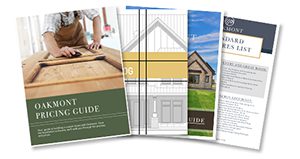The home exterior stone type you choose makes a big difference to the overall look of a home’s exterior. The options–like natural stone, manufactured stone, and faux stone–play a major role in creating your home’s look and curb appeal.
You want something that represents your style but is also cost-effective, durable, and low maintenance.
In this guide, we’ll review all of the many different types of stone for a home’s exterior, and a complete list of styles available, so you have a better idea of what works best for you and your stone exterior home.
Natural Stone Exterior Options

Natural stone exteriors are cuts of naturally occurring stone materials. Due to its natural variances, this type of stone offers a unique look to each home and a timeless endurance to its exterior.
These durable natural stone exterior options provide extra protection to the home’s exterior because they are resistant to weathering and fire damage. It also provides additional insulation, making it an energy-efficient option for your home exterior.
Most homes that utilize natural stone on the exterior use thin slices of naturally occurring stone blocks, usually 1”-2” in thickness. Thin-cut veneer stones provide the advantage of easy transportation, installation, and reduced weight on the exterior of the home.
Installation of natural stone veneer requires mortar or another exterior adhesive. The process of installing cuts of natural stone is more labor-intensive than many other options due to organic variances in the size and shape of the stone.
In addition to complicated installation, mining, producing, and transporting natural stone exteriors make them the most expensive option we’ll review.
For the most high-end appearance and enduring quality, natural stone is the best choice for the exterior of your home.
Types of Natural Stone Used for Home Exterior
There are many styles and colors of natural stone exterior veneer, but most use a few types of naturally occurring stone.
Limestone

A sedimentary rock, limestone comes in various colors and it easily carves or slices into different cut styles. Limestone is a popular option frequently featuring on French Country, Mediterranean, and Contemporary style homes.
Sandstone

Like limestone, sandstone is a sedimentary rock that is versatile and durable. These characteristics have made it one of the most commonly used construction materials for centuries. Sandstone exteriors usually feature on Craftsman, Victorian, and Southwest home styles.
Granite

An igneous rock, granite is exceptionally durable and low maintenance. Comprised of other stones like feldspar, mica, and quartz, granite comes in many different colors and textures. Granite is common on the exterior of Colonial, European, and Craftsman style homes.
Quartzite
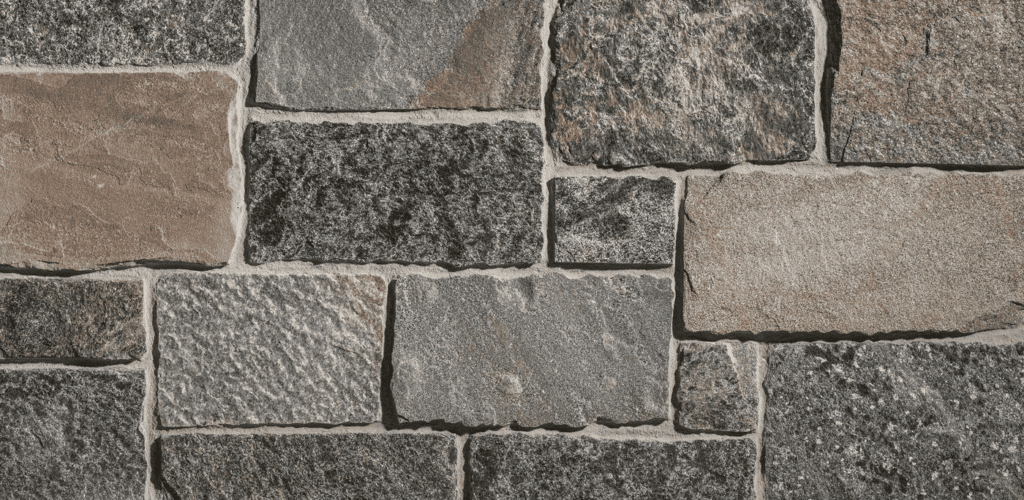
This metamorphic rock is a composite of quartz and sandstone. Quartzite tends to have regular patterns and textures. Contemporary, Modern Farmhouse, and Mountain style homes frequently utilize quartzite exteriors.
All of these natural stone materials come in a wide variety of colors, cuts, and stacking patterns suited to a wide variety of home styles.
Manufactured Stone Exterior Options
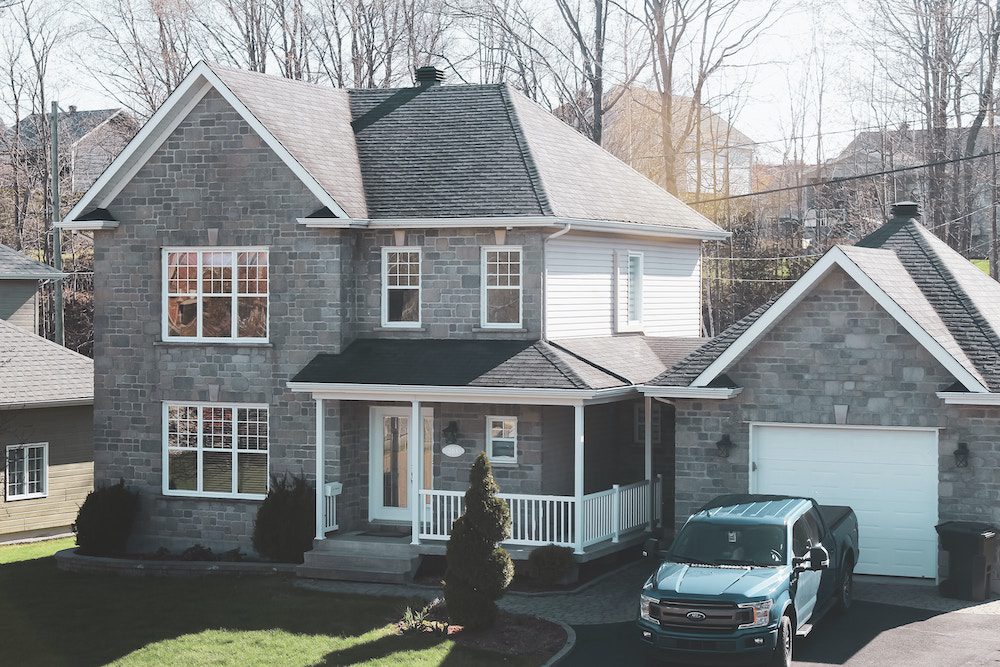
Manufactured or cultured stone is an alternative to natural stone siding. It is a man-made composite of various elements, primarily Portland cement, as well as lightweight stone aggregates and pigments. The mix then sets in casts designed to mimic natural stones like sandstone, granite, and limestone.
As an alternative to natural stone, manufactured stone is lightweight and inexpensive while still providing insulation, protection, and a beautiful appearance.
Because manufactured stone comes from pre-designed molds, it lacks the organic variety in shape and texture found in natural stone veneers. The composite nature of manufactured stones also means they are slightly less durable than natural stone veneers. They also require higher maintenance, since they pressure-washing may cause damage.
Installation of manufactured stone veneers is similar to natural stone. The stones come as individual pieces of thin stone composite, approximately 2”-6” thick. These pieces bond to the exterior of the home using mortar and other adhesives.
The pieces are so lightweight they can provide more dimension and depth to the finish at a lower cost. Installation is also easier due to the consistent patterns and shapes of stones.
Manufactured Stone Veneer Styles
Due to the nature of their creation, manufactured stone comes in just about every color, shape, and style. A few shapes and stacking patterns are common in manufactured stone veneers.
Ledgestone

Jagged in shape with varying depths, manufactured ledgestone is horizontally stacked. Ledgestone can come in varying colors for a rustic appearance or in subtle stones for a smooth, contemporary look.
Fieldstone

Made up of large, irregular shapes with the appearance of natural weathering, fieldstone mimics naturally found stones in rivers or fields. Fieldstone provides a country cottage or rustic appearance to a home.
Ashlar
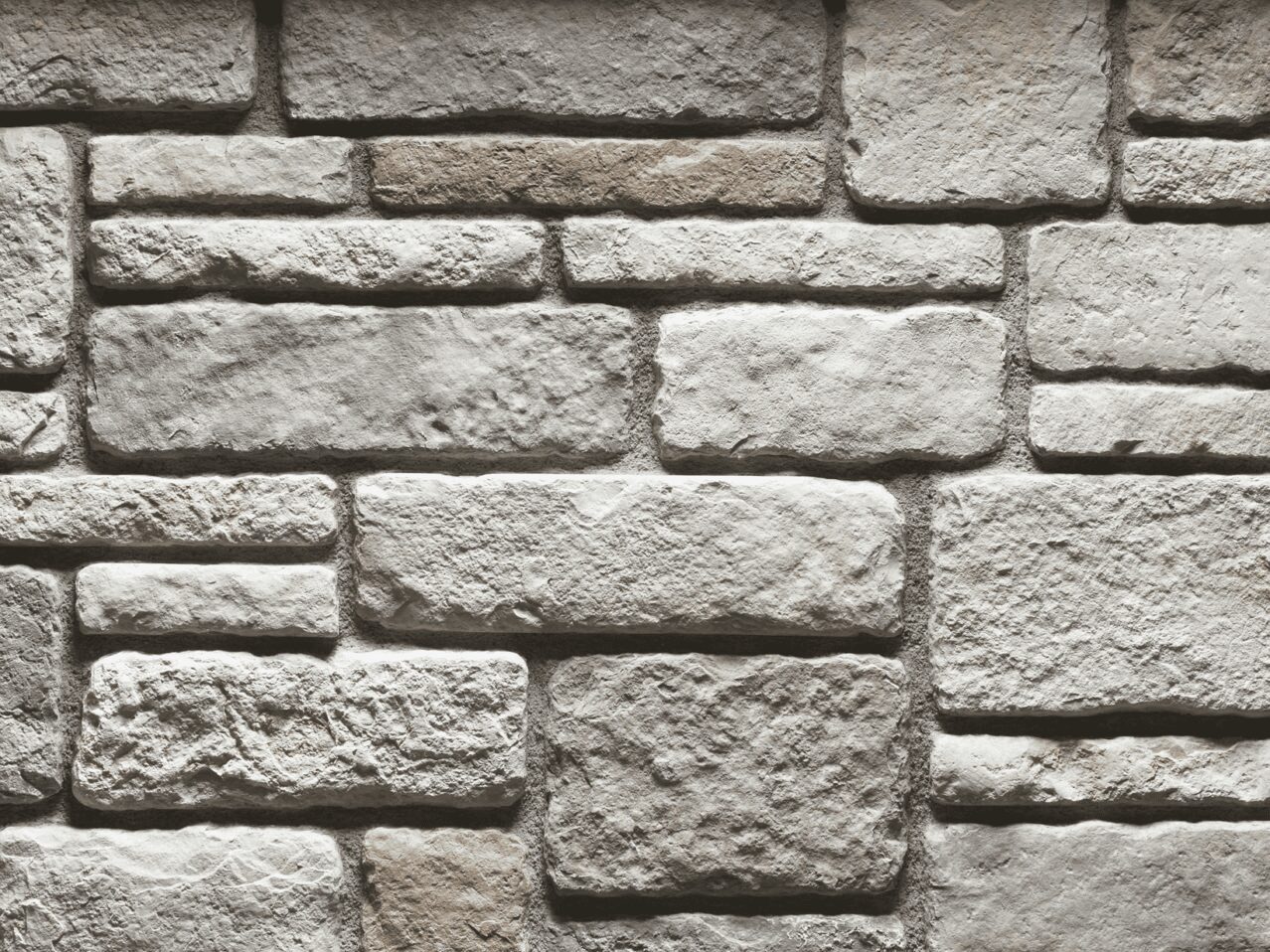
As a traditional masonry style, ashlar veneer makes a home rook refined and formal. Ashlar is made up of square or rectangular stones of uniform color and texture which fit closely together.
River Rock

Mimicking the smooth, rounded rocks found in river beds, river rock veneer provides a rustic, organic look for a home or cabin. Manufactured river rock stones are smooth and polished with large mortar gaps.
Castle Stone

Elegant and clean, castle stone provides an old-world European look. Castle stones are large, squared stones with a smooth finish stacked tightly together.
There are many more varieties of styles and colors for manufactured stone veneer designed to look like naturally occurring stones. You can create any look for your custom home with manufactured stone exteriors.
Faux Stone Veneer

Unlike manufactured stone, which is a composite of stone materials, faux stone veneer options are synthetic materials. These synthetic stone options appear similar to natural or manufactured stone, but with inorganic textures and variations.
Faux stone options for the exterior are usually the most cost-effective option. They are lightweight, compact, and easily produced. Because of this, they are commonly used for DIY home projects.
However, these products tend to lack durability. If installed incorrectly, they can cause mold, rot, or fall off easily. These factors, combined with the shortened longevity of synthetic stone products, make them a tricky choice for your home’s exterior, potentially lowering your home’s resale value.
Two common types of faux stone veneers are polyurethane stones and vinyl veneer panels.
Polyurethane Faux Stone Veneer
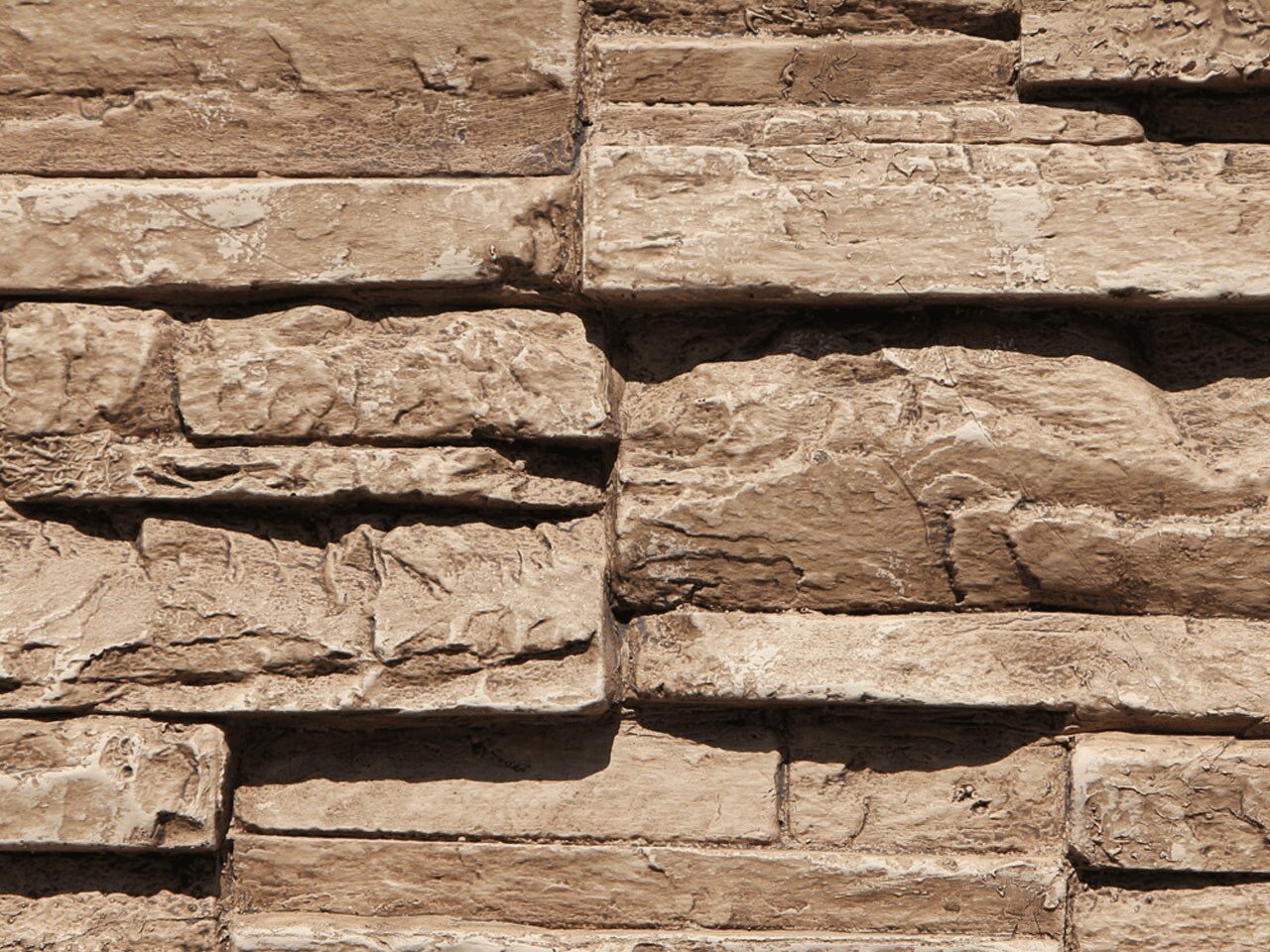
Polyurethane is a dense, plastic-based material similar to foam packaging. It is waterproof and provides additional insulation for the home. This man-made material uses synthetic pigments and molds formed from real stones. It may come as individual stones or in panels.
Faux stones made of polyurethane are incredibly lightweight so they are easy to transport, cut, and install. Because of this, they lack durability and longevity. Polyurethane is highly susceptible to impact damage; even a weedwacker or baseball bat could permanently damage the materials.
While not a perfect product, polyurethane can imitate the look of natural stone at a significantly lower cost.
Vinyl Veneer Panels
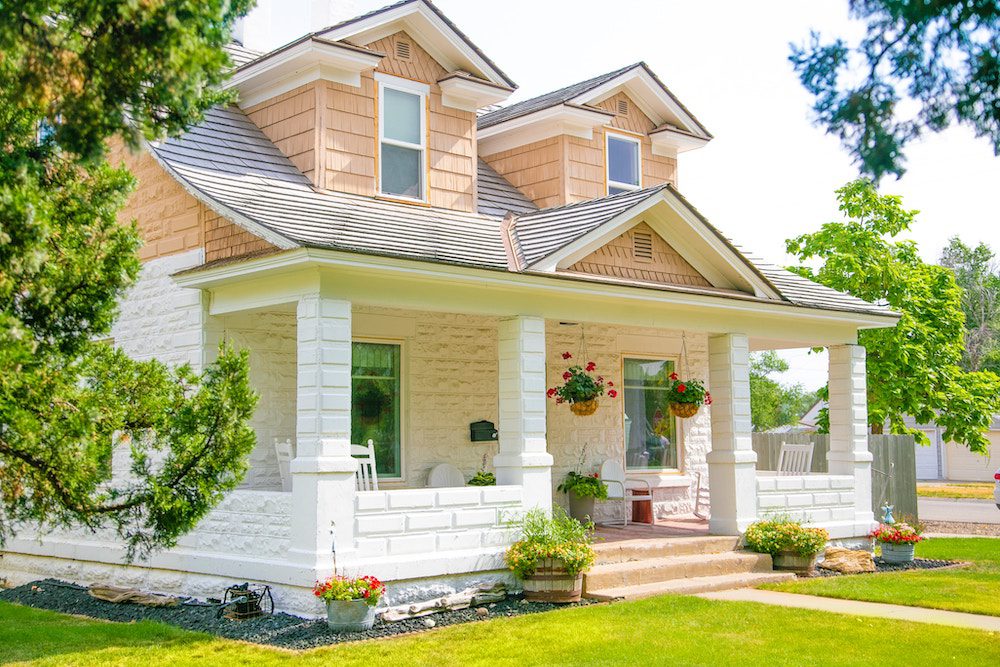
Another synthetic material for faux stone siding is vinyl. Compared to polyurethane, vinyl is a more damage-resistant material. Water and extreme temperatures won’t affect vinyl siding, and they are less prone to impact damage.
Stone-look vinyl siding options are usually panels, approximately 12”x42” or 20”x48” in size. These panels uses real-stone molds and colors to look like natural stone. However, they tend to provide a less realistic look than polyurethane or manufactured stone options.
Trimmable with just a utility knife, installation does not require mortar or adhesives. Panels are trimmed and secured using fasteners like nails or screws. Usually, you need vinyl trim to complete installation.
Though it has downsides, vinyl stone siding is an excellent cost-saving option for replicating the appearance of exterior stone siding.
Conclusion
There are many options when it comes to exterior stone siding, from carved natural stone to vinyl siding panels. Whether you want full stone siding, wainscotting, or just stone accents on the exterior of your home, consider the cost and quality of each option carefully.
If you are considering building a custom home, learn more about building a custom home, or the cost of building a custom home, in our home builder guides.





